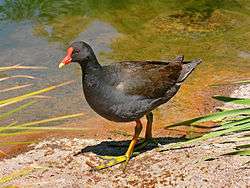Dusky moorhen
| Dusky moorhen | |
|---|---|
 | |
| Scientific classification | |
| Kingdom: | Animalia |
| Phylum: | Chordata |
| Class: | Aves |
| Order: | Gruiformes |
| Family: | Rallidae |
| Genus: | Gallinula |
| Species: | G. tenebrosa |
| Binomial name | |
| Gallinula tenebrosa Gould, 1846 | |
| Synonyms | |
|
Gallinula haematopus Bonaparte, 1856 | |
The dusky moorhen (Gallinula tenebrosa) is a bird species in the rail family and is one of the eight extant species in the moorhen genus. It occurs in India, Australia, New Guinea, Borneo and Indonesia. It is often confused with the purple swamphen and the Eurasian coot due to similar appearance and overlapping distributions. They often live alongside birds in the same genus, such as the Tasmanian nativehen and the common moorhen.
Taxonomy
John Gould described the dusky moorhen in 1846 from a skin collected along the Murray River in South Australia.[2] Its species name is derived from the Latin tenebrosa "dark". Charles Lucien Bonaparte described Gallinula haematopus in 1856, but this is now a nomen nudum. Gregory Mathews described two subspecies that have been synonymized—magnirostris from Western Australia and subfrontata from New South Wales.[2]
Three subspecies are recognised: subspecies frontata from southeastern Borneo, the Sunda Islands, Timor and western New Guinea, subspecies neumannii from northern New Guinea, and the nominate subspecies from Australia.[3]
Common names include dusky moorhen, black gallinule, black moorhen and waterhen.[4]
Description
The dusky moorhen is a medium size bird, slightly smaller than the purple swamphen. The New Guinea birds are smaller, at 25–32 centimetres (9.8–12.6 in) in length,[3] than the Australian race 34–38 centimetres (13–15 in).[5] Adult males generally weigh on average around 570 grams and adult females 493 grams.[3] The adult dusky moorhen is mainly dark grey-black, with a browner tinge to the upper parts. It has a red frontal shield and yellow-tipped red bill like its Eurasian relative, but lacks the white flank line shown by common moorhen, and has orange-yellow rather than yellow legs. The Australian subspecies is larger and pager than both other subspecies.[3]
Distribution and habitat
It occurs in India, Australia, New Guinea, Borneo and Indonesia. In Australia, they are found all across the eastern states of Queensland as far north as Cooktown, New South Wales and Victoria, as well as the eastern part South Australia and the south-western tip of Western Australia.[4] It is also found in parts of Tasmania and South Australia, but are uncommon.[6][7] Included in their natural distribution range are wildlife parks such as Currumbin Wildlife Sanctuary and the Brisbane Botanic Gardens.[8]
The dusky moorhen is found in wetland habitats, with a preference for freshwater marshes and swamps.[5] They are also found in urban parks such as Gold Coast Regional Botanic Gardens and often in dams and river banks.[9][10]
Behaviour
Breeding season is from August to January in the south of Australia, with generally one brood, and January to June in the north, often brooding twice.[11] This species builds a bulky nest of reeds or grasses at the water's edge or a few centrimetres above the water, often at the base of a Melaleuca and lays a clutch of 5–11 matte whitish eggs that are covered with red-brown dots and splotches. Tapered oval in shape, they measure 53 mm long by 36 mm wide each and have more prominent markings at the larger end.[11] It is territorial when breeding, but otherwise gregarious.[3] The dusky moorhen may nest alongside the purple swamphen.[11]
Various views and plumages
 mating
mating Head and cere detail
Head and cere detail Beak and tongue detail
Beak and tongue detail Nesting
Nesting Juvenile
Juvenile Brisbane City Botanical Gardens, Queensland, Australia
Brisbane City Botanical Gardens, Queensland, Australia
References
- ↑ BirdLife International (2012). "Gallinula tenebrosa". IUCN Red List of Threatened Species. Version 2013.2. International Union for Conservation of Nature. Retrieved 26 November 2013.
- 1 2 Australian Biological Resources Study (9 September 2014). "Species Gallinula (Gallinula) tenebrosa tenebrosa Gould, 1846". Australian Faunal Directory. Canberra, Australian Capital Territory: Department of the Environment, Water, Heritage and the Arts, Australian Government. Retrieved 12 September 2014.
- 1 2 3 4 5 Taylor, Barry (2010). Rails: A Guide to Rails, Crakes, Gallinules and Coots of the World. A&C Black. p. 504. ISBN 9781408135372.
- 1 2 "Dusky Moorhen". Life in the Suburbs: Identifying Species in the Bush Capital. Retrieved 11 September 2014.
- 1 2 http://www.birdsinbackyards.net/species/Gallinula-tenebrosa
- ↑ "Dusky Moorhen". Tasmania Parks and Wildlife Service. Retrieved 11 September 2014.
- ↑ http://bie.ala.org.au/species/Gallinula+%28Gallinula%29+tenebrosa
- ↑ http://www.ozanimals.com/Bird/Dusky-Moorhen/Gallinula/tenebrosa.html
- ↑ http://www.mdahlem.net/birds/7/duskhen.php
- ↑ Regional Field Guide to Birds: South-east Coast and Ranges. Harper Collins. 2013. p. 73. ISBN 9781743095850.
- 1 2 3 Beruldsen, Gordon (2003). Australian Birds: Their Nests and Eggs. Kenmore Hills, Qld: self. p. 209. ISBN 0-646-42798-9.
| Wikimedia Commons has media related to Gallinula tenebrosa. |
| Wikispecies has information related to: Gallinula tenebrosa |
